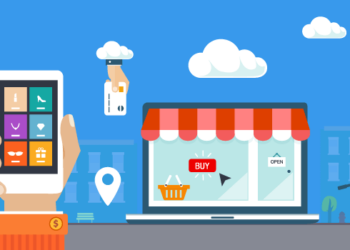When the world of e-commerce continues to evolve, the emergence of Headless Commerce is embraced and set to become a widely adopted technology with the ability to efficiently distribute content. So, what is Headless Commerce? What tremendous benefits does Headless Commerce bring when applied in businesses?
1. What is Headless Commerce?
Headless Commerce is an e-commerce architecture that separates the front-end and back-end, linked by APIs, enabling businesses to easily customize and update functionality without affecting users or content management systems.
- Front-end: What users see and interact with on a website, including the interface, content, and features, received from the back-end.
- Back-end: Unseen parts of the website or app that handle operations like database systems, design tools, management tools, and customizable functions.
Traditional e-commerce platforms tightly couple these two elements, making any changes on the website require improvements to both. Thus, each change becomes riskier and more complex.
The separation of front-end and back-end is crucial, allowing brands to leverage this advantage to create an excellent customer experience across all channels and devices.

2. Characteristics of Headless Commerce:
The secret behind Headless Commerce lies in APIs or application program interfaces. APIs act as an intermediary to connect different applications and libraries, accessing a file of commonly used functions.
Content experienced by customers is managed on the back-end. You can utilize various supporting systems as needed, such as CMS (content management system), CRM (customer relationship management), DXP (digital experience platform), etc.
3. Benefits of Headless Commerce when Applied in Business:
3.1 Increased Customization Capability:
Headless Commerce platforms allow you to achieve the exact interface your brand desires, optimizing the customer experience and increasing conversion rates. In Headless Commerce applications, separating front-end and back-end enables businesses to have endless customization capabilities to design an e-commerce system.
Businesses can optimize e-commerce functionality while customizing the user interface. These operations are simple and less risky because they do not affect the overall system’s operation. Consequently, businesses will capture new opportunities in the market more effectively.
3.2 Faster Page Load Speed:
Headless Commerce platforms no longer link front-end and back-end into a unified entity, helping to store data independently and more centralized through API connections. This method accelerates API call processing compared to traditional e-commerce platforms.
This reduction in the amount of user information to be received and downloaded speeds up page loading to attract customer attention when they access the website. By using Headless Commerce, shoppers can switch between pages and complete transactions at lightning speed.
Moreover, page load speed is a part of SEO (Search Engine Optimization), so improving this aspect will enhance the website’s ranking on search engines like Google, Safari, etc.
3.3 Easy Personalization of the Experience:
In the Headless environment, business owners can manage user experiences on multiple devices without disrupting systems. Furthermore, businesses can easily exploit customer journeys to customize advertisements, shopping suggestions, or set up promotional policies according to their needs and consumer habits.
3.4 Seamless Integration:
Another advantage of API connections is the integration of e-commerce systems. Headless Commerce allows you to integrate all your existing systems to build a shopping experience in the programming language of your choice.
Additionally, API connections make it easy to integrate various third-party services and utilities such as CRM, ERP, PIM, PI. Thanks to this structure, businesses have the ability to quickly test services, utilities, and measure the compatibility with e-commerce campaigns.
3.5 Increased Scalability:
Headless Commerce reduces barriers between countries, making internationalizing online stores easier. You can easily choose multi-currency and multi-language options according to the needs of the business.
Another important aspect of using Headless Commerce structures is the connection between front-end and back-end via APIs. Thanks to this, businesses can easily modify existing features and develop new features when there is a need to expand the system or business model.
3.6 Omnichannel Selling:
When using this structure, API connections also support integration with multiple selling channels more easily. This includes e-commerce platforms, e-commerce websites, e-commerce apps, social networks, or other potential channels in the future.
Headless Commerce also helps optimize content on devices such as desktops, tablets, mobiles connected via the Internet of Things (IoT) to provide a seamless shopping experience for customers.
3.7 Cost Savings in the Long Run:
Operating a Headless Commerce platform is more expensive than a traditional e-commerce website. However, looking at the long term, businesses will see the inherent problems of traditional e-commerce systems, such as:
- Rising operating and upgrading costs of the old system.
- As technology is upgraded and improved, the old system’s load speed becomes slower. If not upgraded, it will affect your website; if upgraded, it will incur significant costs.
Therefore, using the Headless Commerce platform helps your system easily expand/contract and retain customers better. As a result, businesses will save costs for future sales and marketing campaigns while still attracting potential customers to return.
Conclusion:
In conclusion, deploying e-commerce alongside Headless Commerce in the future is essential for businesses with a long-term vision in this market. However, businesses should carefully consider the application and implementation because it depends on the business strategy and other resources within the company.
Cre: Sapo






















Discussion about this post